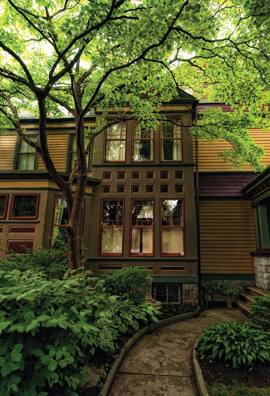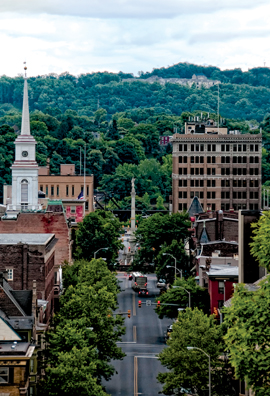College Hill
By Kathryn Finegan Clark
Easton’s College Hill neighborhood was nothing but a forested and uninhabited hunk of mountain sloping down from the 700 – foot high Chestnut Ridge when America declared its independence in 1776.
Easton was one of only three cities where the Declaration of Independence was read publicly on July 4th.
The document, its ink barely dry, was read aloud in Centre Square and in the cities of Philadelphia and Trenton, N.J., on that day, even before American soldiers mustered in New York heard its words.
Today, many of the architect-designed mansions and other homes towering above Easton’s downtown, built a century or so later, fly flags on the Fourth of July, acknowledging the city’s prominent place in the country’s early history.
Years passed, and as the city and the country grew, Lafayette College bought land in 1832 on what it called Mount Lafayette and moved to that site two years later. As common usage changed the name to College Hill, the streets hugging the edge of campus became the College Hill neighborhood of today.
Many of the streets are named after early professors, college presidents or trustees. College Hill’s main artery, Cattell Street, honors Dr. William Cassidy Cattell, a Presbyterian minister who served as Lafayette’s president from 1863 to 1883.
 Many of the structures that line Cattell Street, originally built as residences, have been converted to businesses. Cattell Street is a perfect example of the original egalitarian nature of College Hill, where handsome villas stand next to ordinary homes.
Many of the structures that line Cattell Street, originally built as residences, have been converted to businesses. Cattell Street is a perfect example of the original egalitarian nature of College Hill, where handsome villas stand next to ordinary homes.
A treasured landmark is Begley’s College Hill Tavern at 420 Cattell St., where generations of Lafayette students have either celebrated their triumphs or drowned their sorrows. North of the tavern the neighborhood becomes even more elegant.
Development there blossomed after David W. Nevin established the Lafayette Traction Co. in 1887, erecting an electric trolley line that eventually extended to Paxinosa Street. It was the third such line in the country. Before that the steep hill had made for a strenuous climb for horse-drawn carriages. Nevin also donated to the City of Easton the land which is now Nevin Park, a green and lovely place that runs down to the banks of the Delaware River.
College Hill was listed on the National Register of Historic Places in 1992. While it is primarily residential, it also includes churches, parks and municipal water facilities. It has the single most extensive collection of mid- to late-19th century and early 20th century architecture in the entire Lehigh Valley. Its happy mixture of showplace mansions and simpler homes is especially intriguing.
Many of the homes in the historic district were designed by Easton’s own noted architect, William Michler. One of his Classic Revival mansions is the handsome one at 604 Cattell Street. It was constructed of beige and rose brick and has stucco surfaces.
Between Cattell Street and the river far below, College Hill is marked with wide, tree-lined streets and even wider green lawns that spill down hillsides from homes large and small topped with roofs of slate or tile and surrounded with lush foliage. Vines climb over broad verandas and gardens dance with color along wrought iron or stone fences.
A sense of calm hangs over this quiet and charming neighborhood, a retreat from the bustle of the downtown that at times appears both appealing and almost other-worldly to the casual visitor.
It is, after all, a picture of early 20th century wealthy suburbs, a scene out of history.
The houses closest to campus were built between the 1830s and 1870s and vary from Federal frame and brick row houses to post-Civil War frame and brick Italianate structures. Other homes show a mix of later 19th and early 20th century architecture. Most were built between 1890 and 1920 —the city’s heyday— when industry and trade reached new heights.
 While College Hill is sprinkled with Classic Revival and Colonial Revival designs, Queen Anne styles, such as those at 130 Porter St. and 205 Reeder St., with their corner towers, mansard roofs with fish scale shingles, dormer windows and “gingerbread” ornamentation, actually are predominant among the 19th century homes. Tudor Revival houses with their dark half-timbering and steeply pitched roofs, add a sense of drama as well as English substance to an area that also features many Dutch Colonial and Georgian Revival homes.
While College Hill is sprinkled with Classic Revival and Colonial Revival designs, Queen Anne styles, such as those at 130 Porter St. and 205 Reeder St., with their corner towers, mansard roofs with fish scale shingles, dormer windows and “gingerbread” ornamentation, actually are predominant among the 19th century homes. Tudor Revival houses with their dark half-timbering and steeply pitched roofs, add a sense of drama as well as English substance to an area that also features many Dutch Colonial and Georgian Revival homes.
On Clinton Terrace, the mansion at 406 is a Gothic Revival frame villa with gable trim and a Gothic-detailed bay window, while 319 is a Michler brick Colonial Revival villa.
On High Street an exceptional building is the imposing McKelvy House, built in 1888 for John Eyerman, a faculty lecturer in mineralogy at the time. It later was bought by Lafayette Trustee Francis G. McKelvy and donated to the college by his heirs. It now houses McKelvy Scholars, Lafayette honors students who live there together, sharing intellectual debates and social activities.
The handsome slate-roofed villa with its Norman tower was designed by Stanford White of the New York firm of McKim, Mead, and White, who was shot by millionaire Harry K. Thaw in Madison Square Garden in 1906 after his affair with Thaw’s wife, actress Evelyn Nesbit. The sensational scandal rocked the entire country and was the subject of a 1955 film, “The Girl in the Red Velvet Swing.”
The Lafayette Inn, on West Monroe Street, was built in 1895. The Victorian mansion is now a bed and breakfast that often hosts parents of Lafayette students. Its sprawling grounds make it one of the more picturesque places within the boundaries of College Hill.
The College Hill Neighborhood Association is devoted to preservation and improvement of the district and sponsors neighborhood events including a garden tour each year in June, when the blossoms are at their height.
While College Hill seems rooted in tradition, it also is open to new ideas. Interestingly enough, an old church on Porter Street has been turned into the Abbey Hill Theater. It had its grand opening this spring and will continue to produce entertainment in collaboration with regional theater companies. It’s a nice sign that the city and the historic neighborhood are moving into the 21st century in a friendly and accepting way.
Kathryn Finegan Clark is a National Press Club Award winner who has been writing “Because You Live Here” and other departments for Lehigh Valley Marketplace for several years.





